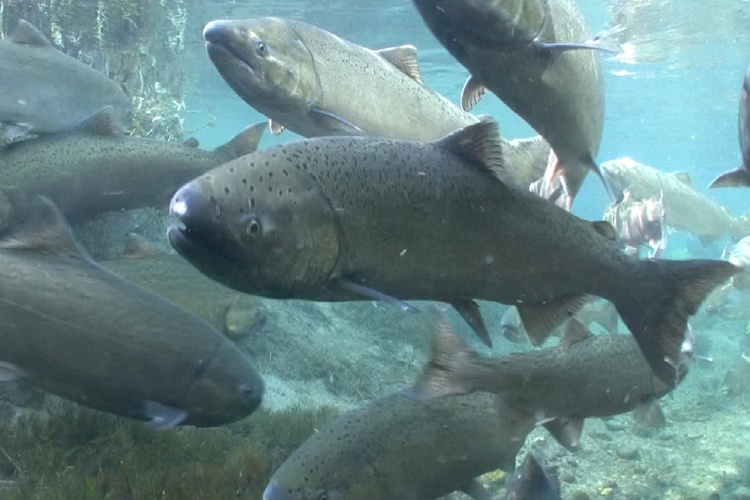(May 15, 2024 -CLACKAMAS, Ore.)—Following an in-season update of the expected upriver spring Chinook return, fishery managers from Oregon and Washington added 10 additional fishing days for recreational spring Chinook downstream of Bonneville Dam during a joint state hearing today, May 15, 2024.
Fishery biologists with the U.S. v. Oregon Technical Advisory Committee (TAC) are now expecting a return of 122,400 upriver-origin adult Chinook, similar to the pre-season forecast of 121,000.
As of May 13, a total of 72,273 adult spring Chinook have passed Bonneville Dam, which is 89 percent of the 10-year (2014-23) average cumulative count and 123 percent of the 5-year (2019-23) average for this date. Typically, 50 percent of spring Chinook have passed Bonneville Dam by May 11.
Season dates, bag limits, areas for the days added today follow:
Downstream of Bonneville Dam
Season: Friday, May 17 through Sunday, May 19; Saturday, May 25 through Monday, May 27; and Wednesday, June 12 through Saturday, June 15
Area: Tongue Point/Rocky Point line upstream to Beacon Rock (boat and bank) plus bank angling only from Beacon Rock upstream to the Bonneville Dam deadline. For exact boundaries visit https://myodfw.com/recreation-report/fishing-report/columbia-zone#Regulation-Updates
Daily Bag Limit: Two adult hatchery salmonids (Chinook or steelhead) per day, but only one may be a Chinook. Shad may also be retained.
All other permanent regulations apply.
Anglers are reminded that from March 1 through June 15 on days when the mainstem Columbia River recreational fishery below Bonneville Dam is open to retention of Chinook, the daily salmonid bag limit in Oregon and Washington Select Areas will be the same as mainstem Columbia River bag limits.
The spring Chinook allocation for the mainstem upstream of Bonneville Dam has already been met, so this area will not reopen until the summer Chinook season begins both upstream and downstream of Bonneville Dams on June 16.
Columbia River spring Chinook salmon seasons require balancing opportunity with Endangered Species Act limitations, provisions in the management agreement between the states, Columbia River treaty tribes, and the federal government that specify harvest sharing of upriver-origin spring Chinook, and guidance from the Oregon and Washington Fish and Wildlife commissions regarding allocations among the non-treaty fisheries.
For the latest on Columbia River fishing regulations, visit https://myodfw.com/recreation-report/fishing-report/columbia-zone#Regulation-Updates
States follow current policy and set 12-hour mainstem commercial fishery
Similar to the recreational fishery, the recent run-size update provides additional upriver spring Chinook for commercial harvest. Consistent with Oregon’s Harvest Reform rules established in 2017, current Columbia River policies of both Oregon and Washington support mark-selective mainstem commercial tangle net fisheries after the in-season run-update when available impacts allow, which is why the Joint Columbia River Management staff proposed the 12-hour mainstem commercial fishery adopted today.
“The Oregon rules regarding Columbia River reform have an off-channel commercial focus pre-run size update, with an 80 percent recreation/20 percent commercial allocation for the spring. Post update, if Select Area commercial fisheries have been fully planned and set, and commercial impacts are still available, then we look at mainstem tangle-net fisheries,” said Tucker Jones, ODFW Columbia River Program Manager, during today’s hearing. “When we modeled these fisheries during the reform process, we only expected them to happen once every two to four years, and that’s about how often they wind up being considered. They can be a small but important piece in the overall commercial economic portfolio and help maintain the commercial infrastructure that is part of overall Columbia River fisheries.”
Commercial buyers report landed catch within 24 hours and state biologists collect data onboard through observations on non-target fish handle, which allows for responsive management to ensure the fishery remains within allocated ESA impacts. Since this is a live-capture mark-selective fishery, in order to maximize survival of released fish, the commercial fishery is required to use: tangle nets (small-mesh nets that minimize injury by entangling the target fish by the teeth instead of catching them by the gills); limited soak times (the time nets are in the water for each drift); recovery boxes (a tool to help recover fish prior to release); and each fisher must have mandatory live capture workshop training (where training on best fish handling practices is provided).


